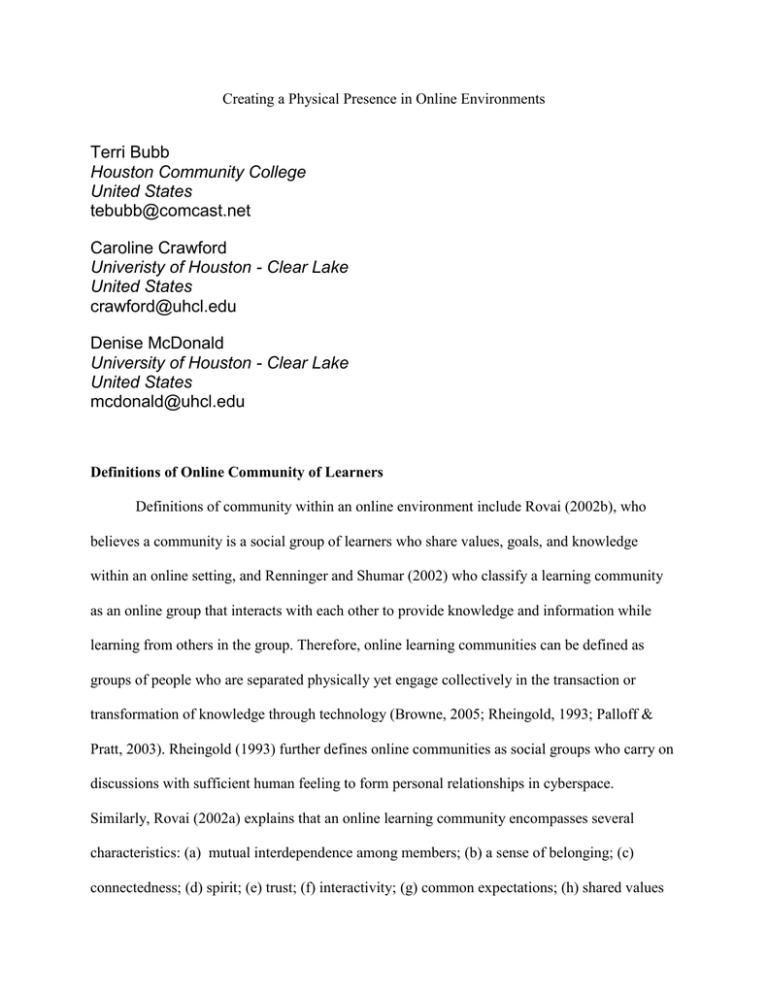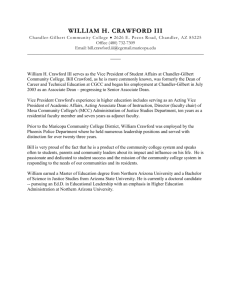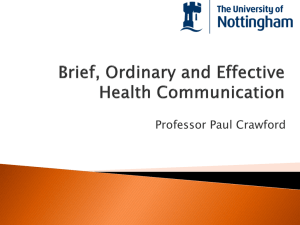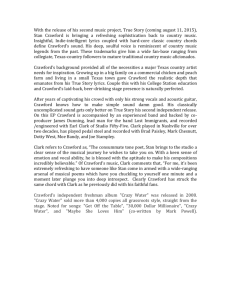Conclusion
advertisement

Creating a Physical Presence in Online Environments Terri Bubb Houston Community College United States tebubb@comcast.net Caroline Crawford Univeristy of Houston - Clear Lake United States crawford@uhcl.edu Denise McDonald University of Houston - Clear Lake United States mcdonald@uhcl.edu Definitions of Online Community of Learners Definitions of community within an online environment include Rovai (2002b), who believes a community is a social group of learners who share values, goals, and knowledge within an online setting, and Renninger and Shumar (2002) who classify a learning community as an online group that interacts with each other to provide knowledge and information while learning from others in the group. Therefore, online learning communities can be defined as groups of people who are separated physically yet engage collectively in the transaction or transformation of knowledge through technology (Browne, 2005; Rheingold, 1993; Palloff & Pratt, 2003). Rheingold (1993) further defines online communities as social groups who carry on discussions with sufficient human feeling to form personal relationships in cyberspace. Similarly, Rovai (2002a) explains that an online learning community encompasses several characteristics: (a) mutual interdependence among members; (b) a sense of belonging; (c) connectedness; (d) spirit; (e) trust; (f) interactivity; (g) common expectations; (h) shared values of goals; and, (i) overlapping histories among members (p. 2). Characteristics of Communities of Learning Researchers have identified some common characteristics that indicate the presence of a learning community within an online environment. Agostinho, Meek, and Herrington (2005), as well as Poole (2000), identify a learning community within an online environment when participants use first names in reference to past comments, and Rheingold (1993) classifies a learning community when participants are respectful and will make an effort to understand others’ views. With regard to etiquette, Schwier (2001) and Shea (2006) find that another characteristic within an online learning community is the use of emoticons, graphics, and color when corresponding with others, while Haythorthwaite (2005) identifies providing support as a key characteristic within an online learning community. Although the characteristics listed above are not exhaustive, they are sufficiently specific in defining an online learning community. Online learning communities provide an open and safe learning environment in which students can actively interact with one another and engage in their learning process (Rovai, 2002a). Members of online communities exhibit behaviors that traditionally identify the presence of community in face-to-face environments, such as a shared history, a common meeting place, commitment to a common purpose, adoption of normative standards of behavior, and recognition of community boundaries (Herrington, Reeves, Oliver, & Woo, 2004; Ingram & Hathorn, 2005; Ingram, Ou, & Owen, 2007; Kanuka & Anderson, 2007; Levy, 2008; Palloff & Pratt, 2003). Developing a sense of community within a group of participants is even more crucial in online learning situations (Ally, 2008; Bonk, Wisher, & Nigrelli, 2004; Brown, 2001; Palloff & Pratt, 2003); and as educators continue to develop quality online courses, looking at creating a community of learners within an online environment is crucial for student academic success. Creating a Physical Presence in Online Environments Research suggests that students who have frequent and meaningful contact within a course, find the interaction beneficial (Brown, 2001). Benefits of student interactions are increased motivation, participation, and performance (Gijselaers, 1996). Crawford (2003) has modified Moore’s (1989) interactions to include a new type of student interaction dubbed, learner-environment interactions which are interactions where students work with resources outside the computer environment to visit external locations. Brown, (2001) refers to this process as widening circle, and these types of interactions focus on connections outside of the community. In these instances, the student’s interact with additional content or other learning communities. Existing research is limited, in this category, and findings of this particular interaction are atypical (Brown, 2001; Crawford, 2003; Moore, 1989). However, researchers agree, when students desire to extend their interactions with online community members beyond textual exchanges, a meaningful connection has taken place within that community (Brown, 2001; Crawford, 2003; Moore, 1989). Online instructors, who witness this type of interaction request from a community member, might offer possible solutions to satisfy this craving of a physical presence. For example, the instructor could introduce into the course freeware and shareware video conferencing, and have the community practice using it. However, no research exists at this time to determine if this technique would be beneficial and further research is warranted in this area. Methodology This study analyzes archival data of a university graduate-level online course in which all course activities are conducted collaboratively through online communications. Communications (i.e., discussion board postings, course assignments and emails) of students in the course and the instructor were examined. Research design utilizing case study and grounded theory was implemented to identify emergent themes and patterns that lead to successful student interaction and engagement within an online higher education course, indicative of a learning community (Berg, 2007; Creswell, 2007). Additionally, findings from this qualitative study propose a blueprint to explain the types of interactive communications which support the development of a how a physical presence in an online environment may be obtained. Conclusion Vygotsky (1978) suggests there is an interrelation between a learner’s cognitive development and the nature of social interactions. Therefore, online learning communities’ environments must carefully consider social communities and the interactivities that will help support the cognitive development of the learners through interactive activities to develop a sense of physical presence in an online environment. Online learning community mediums mandate that communications be not only naturally occurring but also designed into the course environment. Dependent upon the type of online learning community, such as a primarily textbased environment or a three-dimensional virtual world environment, the communicative support has the potential to support the learners in successfully meeting stated learning objectives. Yet, what are these communications? While many types of communications may not be realized as integral interactions, it is important to realize that all forms of communication within an online learning community are integral and must be acknowledged. Therefore, the ability to delineate the different forms of interactive activities is of vital importance (Crawford, 2003). Components of self-regulation, conceptual understanding of the information, the appropriate chunking of information so as to ensure that the information can be framed for purposes of understanding and discussion, and worries related to cognitive load or cognitive overload of the learners can be supported through interactive activities at all levels of delineation. Not only are interactive activities useful towards offering warm fuzzy feelings of belonging and caring, but they ensure that a sense of community for all learners is important. After all, online learning communities may feel as if they are self-contained silos, as quoted from Gannon Cook, and Crawford (2004, p. 446): In the real world, silos usually exist on manufacturing plant-site locations. These silos can exist next to other silos, spread out over a fairly large expanse of land, but still tightly shut and singular. That too is the connotation for silo e-learning, perhaps adjacent or existing next to others in the same electronic spaces, yet still self-contained in their own silos. In e-learning, silos can be a dangerous place in which to exist because nothing can get into a silo, unless it falls in, and nothing gets out, except by climbing out. So, to get students out of their silos, and into dialogue and class participation, there often needs to be more than the standard electronic web board and email web course fare. The social aspects that support the creation of autonomous, dynamic learning communities are enhanced not only by learner engagement regarding the development of bonds of understanding, but also the thoughtful and professional collaboration. Also, considerations towards student engagement and social interaction theory (Bandura, 1986; Jonssen, 2000; Vygotsky, 1978) help an online learning environment become a community of learner reality. References Agostinho, S., Meek, J., & Herrington, J. (2005). Design methodology for the implementation and evaluation of a scenario-based online learning environment. Journal of Interactive Learning Research, 16(3), 229-242. Ally, M. (2008). Foundations of educational theory for online learning. In T. Anderson & G. Sanders (Eds.). Theory and practice of online learning (pp. 1-31). Athabasca, Canada: Athabasca University. Bandura, A. (1986). Social foundations of thought and action: A social cognitive theory. Englewood Cliffs, NJ: Prentice Hall. Berg, B. (2007). Qualitative research methods for the social sciences (6th ed.). Boston: Pearson. Bonk, C.J., Wisher, R.A., & Nigrelli, M.L. (2004). Learning communities, communities of practice: Principles, technologies and examples. In K. Littleton, D. Miell, & D. Faulkner (Eds.), Learning to collaborate, collaborating to learn (pp. 199-219). New York: Nova Science. Brown, R. (2001). The process of community building in distance learning classes. Journal of Asynchronous Learning Networks, 5(2), 18-35. Browne, E. (2005). Structural and pedagogic change in further and higher education: A case study approach. Journal of Further and Higher Education, 29(1), 49-59. Cook, R., & Crawford, C. M. (2004). From silos to communities: Addressing electronic isolation through interactivities. In R. Ferdig, C. Crawford, R. Carlsen, N. Davis, J. Price, R. Weber, & D. A. Willis (Eds.), Society for Information Technology & Teacher Education International Conference Annual (pp. 445-452).Norfolk, VA: Association for the Advancement of Computing in Education (AACE). Crawford, C. M. (2003). Emerging learning environments: Enhancing the online community. Academic Exchange Quarterly 7(4), 131-135. Creswell, J. (2007). Research design: qualitative, quantitative, and mixed methods approaches (2nd ed.). Thousand Oakes, CA: Sage Publications. Gijselaers, W. H. (1996). Connecting problem-based practices with educational theory. In L. Wilkerson & W. H. Gijselaers (Eds.), Bringing problem-based learning to higher education: Theory and practice (pp. 13-21). San Francisco: Jossey-Bass. Haythornthwaite, C. (2005). Social networks and Internet connectivity effects. Information, Communication & Society, 8(2), 125-147. Herrington, J., Reeves, T. C., Oliver, R., & Woo, Y. (2004). Designing authentic activities in web-based courses. Journal of Computing in Higher Education, 16(1), 3-29. Ingram, A. L., & Hathorn, L. G. (2005). Collaboration in online communications. In C. Howard, J. Boettcher, L. Justice, K. D. Schenk, P.L. Rogers, & G.A. Berg (Eds.), Encyclopedia of distance learning: Vol. 1. (pp. 264-268). Hershey, PA: Idea Group, Inc. Ingram, A. L., Ou, C. M., & Owen, R. J. (2007). Cross-cultural issues in online education. The Journal of the Research Center for Educational Technology, 3(1), 32-49. Jonassen, D.H. (2000). Towards a meta-theory of problem solving. Education Technology Research and Development, 48(4), 63-85. Kanuka, H., & Anderson, T. (2007). Ethical issues in qualitative e-learning research. International Journal of Qualitative Methods, 6(2), 1-14. Levy, Y. (2008). An empirical development of critical value factors (CVF) of online learning activities: An application of activity theory and cognitive value theory. Computers & Education, 51(4), 1664-1675. Moore, M. (1989). Three types of interaction. The American Journal of Distance Education, 3(2), 1-7. Palloff, R. M., & Pratt, K. (2003). Virtual student: A profile and guide to working with online learners. San Francisco: Jossey-Bass. Poole, D. M. (2000). Student participation in a discussion-oriented online course: A case study. Journal of Research on Computing in Education, 33(2), 162-177. Renninger, K. A., & Shumar, W. (Eds.). (2002). Building virtual communities: Learning and change in cyberspace. New York: Cambridge University Press. Rheingold, H. (1993). The virtual community: Homesteading on the electronic frontier. New York: Harper Collins. Rovai, A. (2002a). Building sense of community at a distance. International Review of Research in Open and Distance Learning, 3(1), 1-16. Retrieved from http://www.irrodl.org/index.php/irrodl/article/view/79/153. Rovai, A. (2002b). Sense of community, perceived cognitive learning, and persistence in asynchronous learning networks. The Internet and Higher Education, 5, 319-332. Schwier, R. (2001). Catalysts, emphases, and elements of virtual learning communities: Implications for Research and Practice, 2(1), 5-18. Shea, P. (2006). A study of students’ sense of learning community in online environments. Journal of Asynchronous Learning Networks, 10(1), 35-44. Suler, J. (2004). The psychology of text relationships. In R. Kraus, J. S. Zach, & G. Stricker (Eds.), Online counseling: A handbook for mental health professionals (pp. 19-50). Amsterdam: Elsevier. Vygotsky, L. (1978). Mind in society. Cambridge, Massachusetts: Harvard University Press. Wittgenstein, L. (1960). Tractatus logico-philosophicus. London: Routledge.







